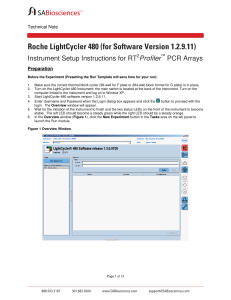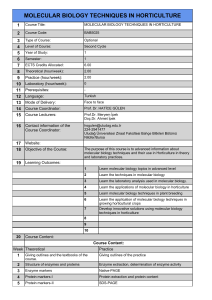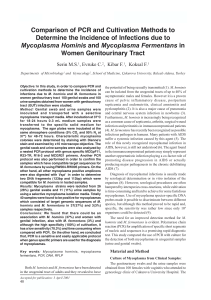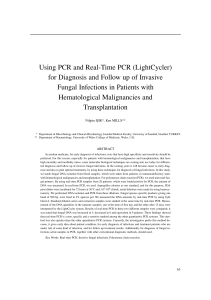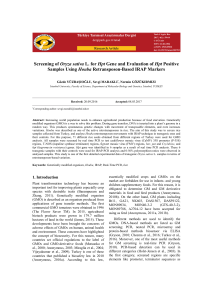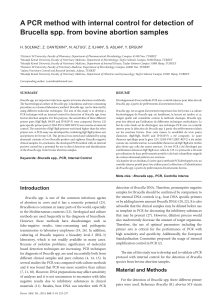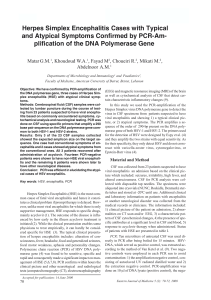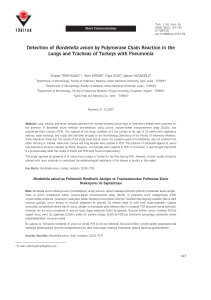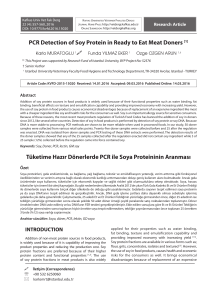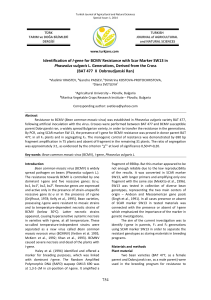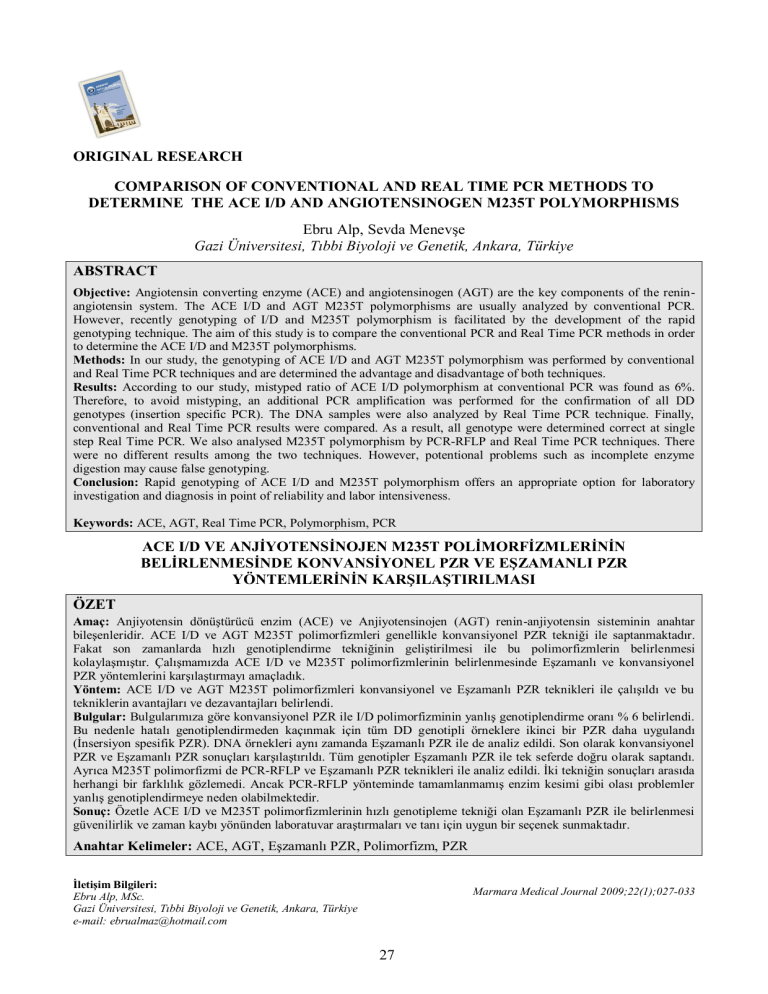
ORIGINAL RESEARCH
COMPARISON OF CONVENTIONAL AND REAL TIME PCR METHODS TO
DETERMINE THE ACE I/D AND ANGIOTENSINOGEN M235T POLYMORPHISMS
Ebru Alp, Sevda Menevşe
Gazi Üniversitesi, Tıbbi Biyoloji ve Genetik, Ankara, Türkiye
ABSTRACT
Objective: Angiotensin converting enzyme (ACE) and angiotensinogen (AGT) are the key components of the reninangiotensin system. The ACE I/D and AGT M235T polymorphisms are usually analyzed by conventional PCR.
However, recently genotyping of I/D and M235T polymorphism is facilitated by the development of the rapid
genotyping technique. The aim of this study is to compare the conventional PCR and Real Time PCR methods in order
to determine the ACE I/D and M235T polymorphisms.
Methods: In our study, the genotyping of ACE I/D and AGT M235T polymorphism was performed by conventional
and Real Time PCR techniques and are determined the advantage and disadvantage of both techniques.
Results: According to our study, mistyped ratio of ACE I/D polymorphism at conventional PCR was found as 6%.
Therefore, to avoid mistyping, an additional PCR amplification was performed for the confirmation of all DD
genotypes (insertion specific PCR). The DNA samples were also analyzed by Real Time PCR technique. Finally,
conventional and Real Time PCR results were compared. As a result, all genotype were determined correct at single
step Real Time PCR. We also analysed M235T polymorphism by PCR-RFLP and Real Time PCR techniques. There
were no different results among the two techniques. However, potentional problems such as incomplete enzyme
digestion may cause false genotyping.
Conclusion: Rapid genotyping of ACE I/D and M235T polymorphism offers an appropriate option for laboratory
investigation and diagnosis in point of reliability and labor intensiveness.
Keywords: ACE, AGT, Real Time PCR, Polymorphism, PCR
ACE I/D VE ANJİYOTENSİNOJEN M235T POLİMORFİZMLERİNİN
BELİRLENMESİNDE KONVANSİYONEL PZR VE EŞZAMANLI PZR
YÖNTEMLERİNİN KARŞILAŞTIRILMASI
ÖZET
Amaç: Anjiyotensin dönüştürücü enzim (ACE) ve Anjiyotensinojen (AGT) renin-anjiyotensin sisteminin anahtar
bileşenleridir. ACE I/D ve AGT M235T polimorfizmleri genellikle konvansiyonel PZR tekniği ile saptanmaktadır.
Fakat son zamanlarda hızlı genotiplendirme tekniğinin geliştirilmesi ile bu polimorfizmlerin belirlenmesi
kolaylaşmıştır. Çalışmamızda ACE I/D ve M235T polimorfizmlerinin belirlenmesinde Eşzamanlı ve konvansiyonel
PZR yöntemlerini karşılaştırmayı amaçladık.
Yöntem: ACE I/D ve AGT M235T polimorfizmleri konvansiyonel ve Eşzamanlı PZR teknikleri ile çalışıldı ve bu
tekniklerin avantajları ve dezavantajları belirlendi.
Bulgular: Bulgularımıza göre konvansiyonel PZR ile I/D polimorfizminin yanlış genotiplendirme oranı % 6 belirlendi.
Bu nedenle hatalı genotiplendirmeden kaçınmak için tüm DD genotipli örneklere ikinci bir PZR daha uygulandı
(İnsersiyon spesifik PZR). DNA örnekleri aynı zamanda Eşzamanlı PZR ile de analiz edildi. Son olarak konvansiyonel
PZR ve Eşzamanlı PZR sonuçları karşılaştırıldı. Tüm genotipler Eşzamanlı PZR ile tek seferde doğru olarak saptandı.
Ayrıca M235T polimorfizmi de PCR-RFLP ve Eşzamanlı PZR teknikleri ile analiz edildi. İki tekniğin sonuçları arasıda
herhangi bir farklılık gözlemedi. Ancak PCR-RFLP yönteminde tamamlanmamış enzim kesimi gibi olası problemler
yanlış genotiplendirmeye neden olabilmektedir.
Sonuç: Özetle ACE I/D ve M235T polimorfizmlerinin hızlı genotipleme tekniği olan Eşzamanlı PZR ile belirlenmesi
güvenilirlik ve zaman kaybı yönünden laboratuvar araştırmaları ve tanı için uygun bir seçenek sunmaktadır.
Anahtar Kelimeler: ACE, AGT, Eşzamanlı PZR, Polimorfizm, PZR
İletişim Bilgileri:
Ebru Alp, MSc.
Gazi Üniversitesi, Tıbbi Biyoloji ve Genetik, Ankara, Türkiye
e-mail: [email protected]
Marmara Medical Journal 2009;22(1);027-033
27
Marmara Medical Journal 2006;20(3);027-033
Ebru Alp, Sevda Menevşe
Comparison of Conventional and Real Time PCR methods to determine the ACE I/D and angiotensinogen
M235T polymorphisms
PCR product formation10. This article
describes a method for SNP detection and
determines an alternative polymorphism
detection strategy. Real time PCR is a much
more rapid and reliable method than the
classical technique for SNP analysis and
especially ACE I/D genotyping. The aim of
this study is to compare the conventional PCR
and Real Time PCR methods in order to
determine the ACE I/D and M235T
polymorphisms.
INTRODUCTION
The renin-angiotensin system plays a
significant role in the regulation of blood
pressure1. Angiotensin-converting enzyme
(ACE) is the most studied component of the
renin–angiotensin system. Elevated ACE
levels have been reported in patients with
heart failure2. Importantly, the ACE I/D
polymorphism was frequently used as a
marker to study cardiovascular diseases.3.
ACE I/D polymorphism is the insertion or
deletion (I/D) of a 287 base pair in intron 16
of the ACE gene2. A number of clinical
studies have shown that the D allele is
associated with higher risk of cardiovascular
disease4.
MATERIAL AND METHOD
This study included 32 patients selected from
our sample bank (collected between 2000 and
2003 from Gazi University, Department of
Cardiology). They had angiographically
defined coronary artery disease (≥50%
stenosis of at least one coronary vessel).
Ethical approval for this study was received
from the Faculty of Gazi Medicine Ethics
Committee. Thirty two genomic DNA were
extracted from whole blood anticoagulated
with K2EDTA using Heliosis® DNA
extraction kit (Metis Biotechnology, Turkey).
Besides ACE, Angiotensinogen (AGT) is also
a key component of the renin–angiotensin
system. The M235T polymorphism of AGT
gene is associated with increased plasma
AGT levels5. The polymorphism is localized
in exon 2 and methionine at position 235 is
replaced by threonine6. The AGT T235 allele
was reported to be significantly associated
with essential hypertension in Caucasians, in
Whites with a positive family history of
hypertension and in Japanese populations2.
Determination of ACE Genotypes by
Conventional PCR
Genomic DNA was amplified in a 50 µL
reaction mixture containing; 75 mM Tris-HCl
(pH 8.8), 200 mM (NH4)2SO4, 0.1% Tween20, 200 µM of each dNTP, 1.5 mM MgCl2, 50
pmol of each set of primers11, 1 unit of Taq
DNA polymerase (Fermentas, Lithuania). The
amplification cycle was carried out in an
automated thermalcycler (MJ Research,
USA). The amplification profile consisted of
initial denaturation at 94 ºC for 5min followed
by 35 cycles of 30 s at 94 ºC, 1min at 58 ºC,
1min at 72 ºC and a final extension time of
5min at 72 ºC. The PCR products were
separated on 2% agarose gel in the presence
of ethidium bromide and visualized with an
UV light. Genotypes were analyzed according
to presence or absence of the insertion allel, II
(homozygote for the insertion allele-490 bp),
ID (heterozygote-490bp and 190 bp) or DD
(homozygote for the deletion allele-190 bp).
All of DD genotypes were subjected to the
second indepentent PCR amplification with a
primer pair that recognize an insertion-
Recently, different methods have been used
for detection of mutations and polymorphisms
such as conventional PCR and Real time
PCR. However, conventional PCR-based
testing formats involve multiple complex
steps and therefore require considerable
expertise to perform7. Other technique is Real
time PCR, used for many different purposes,
especially for quantifying nucleic acids and
for genotyping. Due to the property of Real
Time PCR, the process of amplification is
monitored in real time by using fluorescence
techniques8. Real Time PCR technologies
offer quick and reliable detection of any target
sequence during the detection of genetic
polymorphisms9. Intercalated dyes, such as
SYBR Green I and various probes are used
for Real time PCR. Real Time PCR
instruments measure fluorescence and can
detect the SYBR Green I dye when it is
intercalated with double-stranded DNA,
allowing the detection of double-stranded
28
Marmara Medical Journal 2008;21(1);027-033
Ebru Alp, Sevda Menevşe
Comparison of Conventional and Real Time PCR methods to determine the ACR I/D and angiotensinogen M235T
polymorphisms
specific sequence due to the preferentially
amplification of D allele in the heterozygote
individuals. Insertion specific PCR was
performed according to Lindpaintner et al.12
In the presence of the insertion allele, PCR
products are determined at 335 bp (II
genotype). DD genotypes did not yield any
products.
followed by 45 cycles of denaturation (95 ºC
for 10s, 20 ºC/s), annealing ( 55 ºC for 4s and
65 ºC for 13s, 20 ºC/s) and extension (72 ºC
for 20s 2 ºC/s). For the analysis of the melting
curve at the end of PCR, the reaction mixture
was heated to 95 ºC, lowered to 60 ºC (at 20
ºC/s) and then the temperature was slowly
raised to 98 ºC (at 0.2 ºC/s). The SYBR Green
I fluorescence (F) was continuousuly
measured during the temperature ramp and
then plotted against temperature (T) to obtain
melting curves for each sample. The melting
curves were subsequently transformed to
derivative melting curves [ -(dF/dT) vs T ].
Genotyping of M235T Polymorphism by
Conventional PCR
Genotyping was performed by PCR
amplification of a region spanning the MspI
site with oligonucleotide primers13 in 50 µl of
reaction volumes containing 2.5 µl of DNA,
0.5 µM of each primer, 200 µM of
deoxynucleoside triphosphate (dNTP), 5 µl of
10xPCR buffer (75 mM Tris-HCl (pH 8.8),
200 mM (NH4)2SO4, 0.1% Tween-20), 2.5
mM MgCl2, 1 U of Taq DNA polymerase
(Fermentas, Lithuania), and water to a total
volume of 50 µl. After an initial denaturation
step of 94 ºC for 5min, 30 cycles were
performed at 94 ºC for 30 s, 60 ºC for 1min,
and 72 ºC for 1min. The reaction was
completed by a final extension for 5min at 72
ºC. The PCR products (104 bp) were digested
overnight with 10U of MspI (New England
Biolabs, Beverly, MA, USA), separated on a
3% agarose gel containing ethidium bromide,
and the fragments were visualized with a
Kodak Gel Logic 100 Imaging System
(Kodak Co., USA). The M allele was
determined as 104 bp fragment and T allele
was determined as two fragments, 73 and 31
bp.
Hybridization prob protocol for M235T
polymorphism
PCR and melting curve analysis were
performed LC instrument. The amplification
mixture included 2 µl of DNA (40-80 ng),
4mM MgCl2, 1µl of reaction buffer
(LightCycler Fast Start DNA Master
Hybridization Probes 10X buffer; Roche
Diagnostics, Germany), 10 pmol each of
primers and 4 pmol each of probes (anchor
probe and detection probe)14. The anchor
probe was 5’ labeled with the LC-Red 640
fluorophore and phosphorylated (P) at its 3’
end to prevent probe elongation by the Taq
polymerase. The detection probe was labeled
at the 3’ end with fluorescein. The reaction
mix was prepared in disposable capillaries
(Roche
Diagnostics,
Germany).
The
amplification program consisted of initial
denaturation at 94 ºC for 10min followed by
50 cycles of 94 ºC for 10s (Temperature
Transition Rate 20 ºC/s), 57 ºC for 5s
(Temperature Transition Rate 20 ºC/s) and
72ºC for 20s (Temperature Transition Rate
3ºC/s). After amplification, melting curve
analysis was performed by heating the
reaction mixture to 95 ºC, cooling the
temperature to 40 ºC for 2min and then
temperature slowly raised to 75 ºC at 0,4 ºC/s.
During the melting curve analysis, single
stranded DNA was monitored in channel F2.
Fluorescence resonance energy transfer
(FRET) occurred between the fluorescein dye
and the detection dye LC-RED 640.
Determination of ACE I/D allele by SYBR
Green I dye
Detection of ACE I/D polymorphism was
carried out by Real Time PCR through a LC
(Roche Diagnostics, Germany). PCR and
melting curve analysis were performed in a
final volume of 10 µl containing 2 µl of DNA
(40-80 ng), 10 pmol each of the primers11, 1
µl of LC FastStart DNA Master mix SYBR
Green I (Roche Diagnostics, Germany) and
4mM of MgCl2. The reaction was performed
in disposable capillaries (Roche Diagnostics,
Germany). The cycling program involves a
initial denaturation step (95 ºC for 10min with
a temperature transition rate of 20 ºC/s)
29
Marmara Medical Journal 2008;21(1);027-033
Ebru Alp, Sevda Menevşe
Comparison of Conventional and Real Time PCR methods to determine the ACR I/D and angiotensinogen M235T
polymorphisms
temperature of D allele was at 83.79 ºC, while
the melting temperature of I allele was at
91ºC. The DNA samples were genotyped by
Real Time PCR technique and were
determinated as all genotype concordant. All
conventional and Real Time PCR results were
shown in Table 1.
RESULTS
Genomic DNA was isolated from peripheral
blood samples and the genotyping of ACE
gene was performed by site specific ACE
primers. In this study; 14 DD genotypes, 10
ID genotypes and 8 II genotypes were
observed at the first round PCR with the
conventional PCR technique (Figure 1A).
The angiotensinogen gene region was
amplified with site specific primers and PCR
products were analyzed by RFLP technique.
MM genotype, MT genotype and TT
genotype are displayed in Figure 1C.
To avoid mistyping, each sample having the
DD genotype was amplified by insertion
specific primers. After confirmation PCR
(PCR was performed resulted in DD
genotypes in first round PCR), 12 DD
genotypes were found in concordance with
the first round PCR and the remaining two
samples were found as ID genotypes
(mistyped DD genotypes in the first round
PCR). Mistyped ratio of the first round PCR
was 6%. (Figure 1B).
Each sample, studied by Real Time PCR
technique, was also analyzed with regard to
melting temperature (T allele= 53.60 ºC, M
allele= 62.82 ºC). MM, TT and MT genotypes
are indicated in Figure 2B. According to
conventional PCR and Real Time PCR
results, 9 MM genotypes, 19 MT genotypes
and 4 TT genotypes were detected. In
conclusion, no difference was found between
the Real time PCR and conventional PCR
results.
The same DNA samples were exposed to Real
Time PCR technique and each sample was
analysed with regard to melting temperature.
II, ID and DD genotypes are indicated in
Figure 2A. In ACE genotyping, the melting
Figure 1: Agarose gel photographs of ACE I/D and AGT M235T polymorphisms. (A) Determination of ACE I/D alleles
by conventional PCR. (Separated on a 2% ethidium bromide-stained agarose gel under UV light) M-100 bp DNA
molecular weight marker; lane 4, 6- DD genotype; lane 1,3,5 - ID genotype; lane 2,7- II genotype. (B) Confirmation PCR
of ACE DD genotypes by using insertion specific primers. M-100 bp DNA molecular weight marker; lane 1, 3, 4 - DD
genotype; lane 2, 5 - ID genotype; (The two samples were mistyped the result of first round PCR). (C) Determination of
M235T polymorphism by PCR- RFLP method. (Separated on a 4% ethidium bromide-stained agarose gel under UV
light) M-100 bp DNA molecular weight marker; lane 1, 3- MT genotype; lane 4 - TT genotype; lane- 2, 5 MM genotype
30
Marmara Medical Journal 2008;21(1);027-033
Ebru Alp, Sevda Menevşe
Comparison of Conventional and Real Time PCR methods to determine the ACR I/D and angiotensinogen M235T
polymorphisms
Table I. Comparison of Conventional PCR and Real Time PCR methods for determining ACE I/D polymorphism
Conventional PCR
First PCR Results
Second PCR Results
Final Results
8 II
DD- DD : 12
8 II
10 ID
DD- ID : 2
12 ID
14 DD
12 DD
8 II
Real Time PCR
___
___
12 ID
12 DD
Figure 2: Real Time PCR graphics of ACE I/D and AGT M235T polymorphisms. (A) Melting Curve
Analysis of ACE I/D polymorphism with SYBR Green dye. Arrows demonstrates DD, ID and II genotypes at
different melting temperatures. Water was used as a negative control. (B) Melting Curve Analysis of M235T
polymorphism with hybridization probes. Arrows demonstrates TT, MT and MM genotypes at different
melting temperatures. Water was used as a negative control.
confirmation of all DD genotypes. According
to Perna et al.16, the cause of mistyping is the
preferential amplification of the shorter D
allele. Similarly, Lindpainter et al.12 and
Evans et al. improved confirmation PCR in
order to avoid mistyping. Evans et al. used
three primers, one of which is an insertion
specific primer, to prevent preferential
amplification (65 bp-D allele, 84 bp-I allele
PCR product)17. However, optimization of
primer concentration has became an important
DISCUSSION
Recently, genotyping of ACE has become
important for the determination of several
human cardiovascular disease and nephropaty
disorders. Rigat et al.11 determined ACE I/D
polymorphism and improved a rapid PCR test
for ACE genotyping. However, Shanmugam
et al.15 realized the possibility of mistyping ID
heterozygotes with this PCR method. As a
result, to avoid mistyping, an additional PCR
amplification was developed for the
31
Marmara Medical Journal 2008;21(1);027-033
Ebru Alp, Sevda Menevşe
Comparison of Conventional and Real Time PCR methods to determine the ACR I/D and angiotensinogen M235T
polymorphisms
problem. In our study, ACE genotyping was
performed by site specific ACE primers as
previously described by Rigat et al.11. Figure
1A shows the 7 of 32 individuals, including
II, ID and DD genotypes. To avoid mistyping,
each sample having the DD genotype was
amplified by insertion specific primers12.
While mistyping ratio was found 5% in the
Rigat’s study, we found 6%11. Nevertheless,
another ACE genotyping was performed by
Lin et al. and the mistyping ratio was found as
20%18. We think that the high mistyping ratio
is due to unsuitable PCR conditions.
by Somogyvari et al.19. They used marked
fluoresans and LCRed-640 probe at this
technique. However, using fluoresans or other
specific probes make the technique very
expensive. Consequently, we prefer using
SYBR Green I dye and two primers
previously described by Rigat et al.11 used for
conventional PCR. In our study, same DNA
samples were performed by Real Time PCR
technique and each sample was analysed with
regard to melting tempereture. We found
accurate genotype results for ACE I/D
polymorphism at a single reaction.
Besides the conventional PCR, rapid RealTime PCR genotyping of mutations or
polymorphisms is more useful than standard
PCR in laboratory investigations and
diagnosis. Because it is highly accurate and
less labor intensive, this technique can be
applied to many quantitative analyses and
detections of mutations and polymorphisms in
the clinical laboratory. Different dyes and
probes such as SYBR Green I and
hybridization probes can be used for Real
Time PCR. In ACE genotyping, Real Time
PCR takes advantage of the fluorescent
peculiarity of SYBR Green I dye and the
melting curve analysis that allows the
detection and distinction of different length of
PCR products18. Thus, determination of ACE
genotype can be carried out in a rapid and
reliable way. Recently, Hiratsuka et al. have
developed the Real Time PCR method for the
determination of the ACE genotype10. In this
study, while three peaks were indicated for I
allele, one peak was observed for D allele.
Due to preferential amplification of the
shorter D allele, the melting peak for D allele
was usually more evident than the three
melting peaks of the I allele. Hence,
mistyping of DD allele is still an important
problem. Similarly, Lin et al. performed
SYBR Green I-based method for genotyping
of ACE gene18. This study is required for
further
optimization of the
primer
concentration, because this technique is based
on the method by Evans et. al. who used the
three primers mentioned above.
Because of fluorescent property of SYBR
Green I dye, sensivity of Real Time PCR and
appropriate primer pairs and PCR conditions ,
ACE genotyping was performed seamlessly.
In summary, the Real Time PCR based
method provides a rapid and sensitive way for
detection of ACE gene I/D polymorphism in
clinical samples.
Angiotesinogen M235T polymorphism is a
genetic risk factor for cardiovascular disease.
Rapid and reliable genotyping is important in
the determination of the predisposition of the
individual to cardiovascular disease. Lately,
denaturing gradient gel electrophoresis,
sequencing, or restriction endonuclease
digestion are used for determination of this
polymorphism. Real Time PCR and
conventional PCR techniques for M235T
polymorphism analysis was not compared in
advance. According to the various studies, the
PCR-RFLP technique is the usual method for
detecting
angiotensinogen
M235T
polymorphism. However, this process
requires at least 4-6 h and includes various
post amplification handling steps. The same
steps are carried out approximately in 20 to
30 minutes by Real time PCR. On the other
hand, post amplification handling step may
associate with end product contamination.
Besides, this process might result in an
incomplete enzyme digestion. In Real Time
PCR with no post-amplification processing,
these potential problems are eliminated. In
our study, angiotensinogen region was
amplified with site specific primers and PCR
products were analyzed using the RFLP
technique.
Apart from SYBR Green I dye study,
hibridazation Probe technique was carried out
32
Marmara Medical Journal 2008;21(1);027-033
Ebru Alp, Sevda Menevşe
Comparison of Conventional and Real Time PCR methods to determine the ACR I/D and angiotensinogen M235T
polymorphisms
5.
Since M235T polymorphism is a single
nucleotide change, the hybridization probe
technique is more suitable to get reliable
results. Therefore, we used the hybridization
probe technique that was previously
described14. Each sample, studied by Real
Time PCR technique, was analyzed with
regard to melting temperature. We genotyped
all samples and found very good concordance
RFLP results. According to conventional PCR
and Real Time PCR results, 9 MM genotypes,
19 MT genotypes and 4 TT genotypes were
found. In conclusion, no differences were
observed between the Real Time PCR and
PCR-RFLP results.
6.
7.
8.
9.
10.
In our study, the Real Time PCR is useful as a
genetic test for especially ACE I/D
polymorphism associated with blood pressure
regulation, heart failure, heart attack and
hypertension. This method offers an
appropriate option for reliability and labor
intensiveness. It seems suitable for both
population-based screening and clinical
diagnosis of the ACE I/D and M235T
polymorphism.
11.
12.
13.
ACKNOWLEDGEMENTS
This study was partly supported by the Metis
Biotechnology and the Department of
Medical Biology and Genetics. We thank Dr.
Ece Konac, Ilke Onen and Pinar Eryigit for
reading and advice on the manuscript.
14.
15.
16.
REFERENCES
1.
2.
3.
4.
17.
Rankinen T, Gagnon J, Perusse L, et al. AGT M235T
and ACE ID polymorphisms and exercise blood pressure
in the HERITAGE Family Study. Am J Physiol Heart
Circ Physiol 2000; 279: H368–H374.
Marteau JB, Zaiou M, Siest G, Visvikis-Siest S. Genetic
determinants of blood pressure regulation. J Hypertens
2005; 23(12): 2127-2143.
Pilati M, Cicoira M, Zanolla L, Nicoletti I, Muraglia S,
Zardini P. The role of angiotensin-converting enzyme
polymorphism in congestive heart failure. Congest Heart
Fail 2004; 10: 87–93
Arima H, Kiyohara Y, Tanizaki Y, Nakabeppu Y, Kubo
M, Kato I. Detection of angiotensin-converting enzyme
gene insertion/deletion polymorphism from paraffinembedded tissues. Circ J 2002; 66: 1034–1036.
18.
19.
33
Ashavaid TH, Shalia KK, Kondkar AA, Todur SP, Nair
KG, Nair SR. Gene polymorphism and coronary risk
factors in Indian population. Clin Chem Lab Med 2002;
40: 975-985
Agachan B, Isbir T, Yılmaz H, Akoglu E. Angiotensin
converting enzyme I/D, angiotensinogen T174MM235T and angiotensin II type 1 receptor A1166C gene
polymorphism in Turkish hypertensive patients. Exp
Mol Med 2003; 35: 545-549
Cockerill FR. Application of rapid-cycle Real-Time
polymerase chain reaction for diagnostic testing in the
Cclinical microbiology laboratory. Arch Pathol Lab Med
2003; 127: 1112-1120.
Wilhelm J, Pingoud A. Real-Time polymerase chain
reaction. ChemBioChem 2003; 4: 1120 -1128.
Wittwer CT, Ririe KM, Andrew RV, David DA, Gundry
RA, Balis UJ. The LightCycler: A microvolume
multisample fluorimeter with rapid temperature control.
Biotechniques 1997; 22: 176-181
Hiratsuka M, Kishikava Y, Narahara K, et al. Detection
of angiotensin-converting enzyme insertion/deletion
polymorphism using Real Time polymerase chain
reaction and melting curve analysis with SYBR Green I
on a Geneamp 5700. Anal Biochem 2001; 289: 300-303.
Rigat B, Hubert C, Corvol P, Soubrier F. PCR Detection
of the insertion/deletion of the human angiotensin
converting enzyme gene (DCP 1) (Dipeptidyl
Carboxypeptidase 1). Nucleic Acids Res 1992; 20:
1433–1346.
Lindpaintner K, Pfeffer MA, Kreutz R, et al. A
prospective evaluation of an angiotensin converting
enzyme gene polymorphism and the risk of ischemic
heart disease. N Engl J Med 1995; 332: 706–711.
Morise T, Takeuchi Y, Takeda R. Rapid detection and
prevalance of the variants of the angiotensinogen gene
in patients with essential hypertension. J Intern Med
1995; 237: 175-180.
Malin R, Wirta V, Hiltunen TP, Lehtimaki T. Rapid
detection of angiotensinogen M/T235 polymorphism by
fluorescence probe melting curves. Clin Chem 2000; 46
(6 Pt 1): 880-881.
Shanmugam V, Sell KW, Saha BK. Mistyping ACE
heterozygotes. PCR methods Appl 1993; 3: 120-121.
Perna NT, Batzer MA, Deininger PL, Stoneking M. Alu
insersition polymorphism: A new type of marker for
human population studies. Hum Biol 1992; 64: 641-648.
Evans AE, Poirter O, Kee F. Polymorphism of the
angiotensin converting enzyme gene in subjects who die
from coronary heart disease. Quart J Med 1994; 87: 211214.
Lin MH, Tseng CH, Tseng CC, Huang CH, Chong CK,
Tseng CP. Real Time PCR for rapid genotyping of
angiotensin-converting
enzyme
insertion-deletion
polymorphism. Clin Biochem 2001; 34: 661-666.
Somogyvari F, Szolnoki Z, Marki-Zay J, Fodor I. Real
Time PCR assay with fluoresan hybridization probes for
exact and rapid genotyping of the angiotensinconverting
enzyme
gene
insertion/deletion
polymorphism. Clin Chem 2001; 47: 1728-1729

